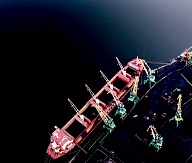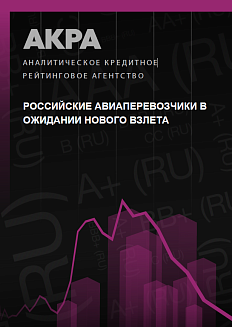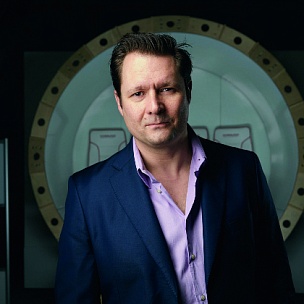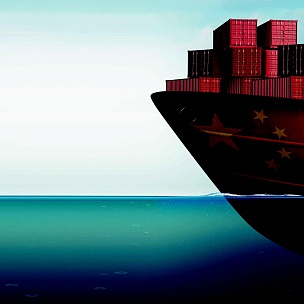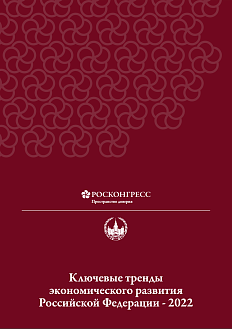Development of the railway infrastructure stimulates an increase in port capacity. It is obvious that ports are capable of changing the architecture of world trade routes over the next decade.
Heritage
Approximately 90% of the worlds trade is carried by sea. Taking into account the fact that the volume of trade is increasing each year, the presence of modern, functioning ports plays a large part in determining a countrys geopolitical position. Contemporary Russia has essentially had to build their port infrastructure from the ground up. The Soviet Union did not develop its ports. At all. Why? They simply had no need to.
Soviet leaders were not interested in upholding trade relations with the world. Back then there were only four more or less functional ports: St. Petersburg, Murmansk, Vladivostok, and Novorossiysk. Plummeting maritime trade was the first sign of the impending fall of the Soviet Union. The figures speak for themselves: in 1984, the cargo throughput of Soviet ports amounted to 456 million tonnes. By 1990, during the empires sunset years, ports were already handling fewer than 400 million tonnes. In 1992, Communism collapsed, and 110 million tonnes of cargo were turned over. By the end of the century, these ports had become dinosaur skeletons, monuments to years of disuse and indifference.
In the early 2000s, the countrys dockyards finally started showing new signs of life. Tankers carrying petroleum and oils, barges loaded with grain, sugar, and cement, and ships transporting timber and metals started appearing in ports once again. The annual cargo throughput started to grow, doubling that of the average figures for all Soviet terminals combined. Moreover, now they didnt just need shipments, they needed modern infrastructure.
The country had to act fast to meet the demands of the time. Svetly (2000), Primorsk (2001), Ust-Luga (2001), Vysotsk (2002), Baltiysk (2002), Taman (2008), Sabetta (2012) ports started sprouting up everywhere. At the same time, new trade routes were developing: the Northern Sea Route, the New Silk Road, shipping lanes from the Baltic to the Middle East. A few years ago, the Russian government realized that ports needed to become drivers of trade, capacities needed to increase, and access routes needed to be built, so they turned their eyes to the sea.

Vladimir Putin said that the Northern Sea Route would be key to development of the Russian Arctic and Far East. Kandalaksha Port anticipates changes
Give and take
Five years ago, Russias port system grew through the addition of five new ports from the Crimean Peninsula. This brought the number of Russian maritime ports to 67. Together, they transport over 60% of the countrys petroleum exports. They also send and receive raw materials, timber, grain, fish...
On 7 May 2018, Vladimir Putin signed an executive order establishing the national goals and development objectives up to 2024. Included in those goals was squaring away the nations transport infrastructure: expanding rail and automobile access to ports, growing the throughput of sea hubs, and increasing the transit capacity of the Northern Sea Route.
For their own part, the government created a plan for implementing the head of states transport and port objectives, which included 11 federal projects. Nine of them were directly related to port development. This included increasing the throughput of port access roads from their current level of 84 million tonnes to 125 million tonnes and increasing the general throughput of domestic ports to 1.3 billion tonnes. For comparison, combined port throughput in 2018 amounted to 816.5 million tonnes.
From 1992 to 2015, USD 1 trillion was invested in global port infrastructure. And even this was not enough to completely satisfy demand and maintain a sufficiently high port construction and modernization rate
And the nations leaders arent planning to stop there. What is already being done today? First of all, new terminals are being built: Murmansks Lavna Terminal will process 18 million tonnes and the Muchke Bay Terminal in Khabarovsk Territory will handle another 24 million
tonnes. Second, there is the construction of new ports: Dikson in the Yenisei Gulf and the modernized Taman in the Black Sea will add 72 million tonnes to the total port throughput. Particular attention is being paid to the development of the Vostochny-Nakhodka transport complex. After infrastructure improvements, its throughput will increase by 31 million tonnes.
Of course, these changes require corresponding levels of investment. Early estimates suggest that the modernization of existing ports up to 2024 will cost RUB 927 billion. A separate budget item, the Northern Sea Route, will require approximately another RUB 588 billion. These are certainly sizeable figures, especially considering the fact that the government originally planned to spend no more than RUB 60 billion a year on modernizing harbour infrastructure.
Yuriy Tsvetkov, Deputy Minister Transport of the Russian Federation; Head, Federal Agency for Maritime and River Transport: The colossal amounts of funding for these federally owned facilities will come from non-budgetary sources, who will then be conceded use of the constructed infrastructure.
Of course, port infrastructure development would be impossible without business participation, concession agreements, and public-private partnerships. At least two projects funded with private capital are expected to be launched as early as this year. The first is the construction of the dry cargo zone in the Port of Taman. RUB 114 billion of the projects total cost of RUB 171 billion may come from concession agreements related to port infrastructure. OTEKO will fund the construction of railroad facilities, an access canal, and operational waters.

The Big Port of St. Petersburg is one of Russias top five biggest ports by cargo turnover
An analogous situation is already being implemented in the Lavna Port in Murmansk Region. In accordance with a 20-year contract, Lavna Sea Trading Port will invest RUB 26.7 billion in the construction of a coal terminal and the development of existing rail infrastructure.
Irina Olkhovskaya, First Deputy Gener Director, Commercial Director of the Port Management Company: Today, ports are modern pieces of infrastructure, utilizing the newest technologies, massively implementing the latest digital solutions, and nearing complete automation.
Access infrastructure remains a critical issue for maritime harbours. It doesnt just need to be adapted to new conditions, it needs to be restructured entirely. Especially in the Far Eastern region, where 90% of cargo throughput is exported, with over 30% heading to China.
Heading east
More attention than ever is being paid to Far Eastern ports. After all, they are the foundation of the nations economic strategies and vital geographic points in the flow of goods between Russia and Asia. The majority of the cargo making its way through Far Eastern ports will be coal (around 50%) and petroleum and petroleum products (25%). AsiaPacific countries are one of the primary consumers and partners in the transport of part of this cargo. Moreover, the throughput of shipping containers is also growing. China is the source of these new container flows in local ports. For example, in 2018, the cargo throughput from China, along sea routes and across the border, amounted to 72.5 million tonnes 1 million tonnes more than in 2017.
The maritime sector is not the only one benefiting from work with Chinese companies. Given that the majority of the end-users of Asian goods are located in Western Russia and in Europe, rail and automobile transport companies are also benefiting. Speaking of which, theres plenty of room for growth in transport.
Sergey Grinyaev, General Director, Centre for Strategic Estimations and Forecasts: China currently receives up to 60% of its energy and extractive resources by sea. Beijings access to a northern corridor would open up absolutely new opportunities for their global strategies, providing them with steady footing and allowing them to concentrate their efforts on promoting their interests in the South-East and on ther continents (primarily in Africa).
After all, the current state of Eastern polygon (the BaikalAmur Mainline and Trans-Siberian Railway) infrastructure slows down coal shipments by more than 20 million tonnes annually. Experts conclude that by 2020 that deficit could amount to 30 million tonnes.
In order to avoid this fate, Russia is actively developing new transport routes. Russian Railways has already announced that it will invest RUB 700 billion in coal transport infrastructure in Siberia and the Russian Far East. But there are even larger projects in play. For example, the international One Belt, One Road initiative. The project, proposed by China, involves the modernization of existing and creation of new trade routes (both by sea and by land), transport, and economic corridors which will unite over 60 countries in the future. The MoscowKazan high-speed railway will be part of this project and will later be connected to Beijing.
Another promising large joint project, and simultaneously a measure to increase ports coal transport capacities, is the construction of the Port Vera Coal Terminal. Currently, Rostec is its only investor, but China, as the primary consumer of Amur region coal, is not against joining the endeavour.



Leading with coal
Multimillion rouble investments in coal terminals are a good idea, but it requires some foresight and some thorough risk analysis. What if this investment cant be recouped? Currently, due to a lack of port capacity, the cost of coal transport is high, from USD 1825 per tonne, when just four years ago, it never topped USD 5. Notably, current returns on investment in coal are also high. The creation of new terminals will be a corrective measure: once the deficit is dealt with, the cost of transport will fall. Which means that it will take business people longer to recoup what they spent on coal ports.
But this is also survivable. As long as we can find a market for this much raw material. China has halted the construction of new coal thermal power stations with a total installed capacity of 150 GW until 2020. This has been done to address the oversupply of electrical energy and in the interest
of environmental protection. This begs a question that stevedores are afraid to ask. What if Chinas coal bubble bursts and the country just stops needing that much fuel? The result wont be as simple as sluggish return on investment. China has already significantly reduced coal consumption. The first warning sign for domestic companies was Chinas freeze of thermal power station projects.

LNG sales have quadrupled over the last two decades. Deloitte estimates that LNG sales will double in the next twenty years. The Northern Sea Route will be actively
used for exports
This is, by the way, a global trend. The United Kingdom, with its wealth of coal mines, will close all electrical power stations powered by coal by 2025. In Germany, who is the largest consumer of Russian coal, there is talk of completely stopping all use of coal by 2030. Even in the United States, certain states plan to get all of their power from renewable resources by 2045. There are plenty of reasons for this sudden freeze. One of the more obvious is probably the environment.
The majority (57%) of the financing for public-private partnership port infrastructure projects will come from private shareholders. Another 23% will come from development banks, 15% will come from the government, and just 6% will be sourced from commercial banks
At the same time, new coal complexes are being built, taking new environmental safety requirements into account. The release of harmful coal dust during seaport transport has been reduced. Just three years ago, 45 tonnes of coal dust were released per port per year. In 2019, thanks to the implementation of new technologies, this figure has been reduced to 18 tonnes. The plan is to reduce coal dust emissions to below 10 tonnes a year.
Port efficiency will also increase thanks to digitalization. In the near future, the delivery, transport, and processing of cargo will go digital. In other words, Russia is implementing a Smart Port system. What does that mean? Lets say that a company buys raw materials through a trade portal. Immediately after payment is received, a ship is charted and loaded automatically. At the same time, also on autopilot, is the preparation of all required documents, including customs permits.
In this way, a radically new approach to logistics is born, minus the human factor, bureaucracy, and red tape. The system has already proven itself in the West. In Russia, the Port of Ust-Luga already transitioned to automation last year. And now the delivery, unloading, and departure of train cars at the terminal is 98% digital. Port Management Company, which manages the Vostochny Port and Rosterminalugol coal terminals, has already expressed interest in implementing technology at the Nakhodka-Vostochnaya station.
All in all, we can confidently say that, today, Russias ports are facing, if not their best years (we hope that theyre still ahead), then, at the very least, good years. Is this the chance to strengthen Russias position in the region and the world by leveraging 67 resource and financial magnets?
RUSSIAS BIGGEST SEAPORTS








